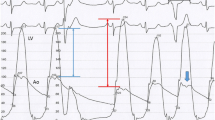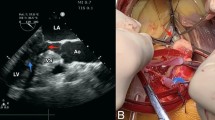Abstract
The presence of intraventricular obstruction is a powerful predictor of outcome in patients with hypertrophic cardiomyopathy (HCM) and, when associated with severe, drug-refractory symptoms, should be managed aggressively. Resting left ventricular outflow obstruction is found in approximately 20% of the patients, classically occurs at the subaortic level, and is associated with mitral valve systolic anterior motion (SAM). In a minority of patients, however, the impedance to flow occurs at midventricular level, unrelated to SAM. Symptomatic midventricular obstruction represents a clinical challenge, and its treatment is not standardized. In these patients, both surgical myectomy and alcohol septal ablation (ASA) are technically feasible. A rational approach to the management of these patients depends on accurate characterization of the pathophysiology, coupled with comparison of the results of different management strategies. To illustrate these points, the details of a patient who first underwent percutaneous ASA and subsequently required redo surgical treatment are described here, with special emphasis on the implications to the management of midventricular obstruction, as well as to the more global issue of obstructive HCM.
Zusammenfassung
Unter Ruhebedingungen findet sich bei Patienten mit hypertrophischer Kardiomyopathie in ca. 20% der Fälle ein Ausflussbahngradient. Sein Nachweis ist ein bedeutsamer prognostischer Faktor. Die mit schweren, medikamentös nicht beeinflussbaren Symptomen verbundene Ruheobstruktion bedarf einer invasiven Therapie. Die klassische linksventrikuläre Ausflussbahnobstruktion findet sich subaortal, verursacht durch oder assoziiert mit systolischer Vorwärtsbewegung (SAM) des vorderen Mitralsegels. Seltener findet sie sich mittventrikulär, ohne Beziehung zur SAM. Die mittventrikuläre Obstruktion stellt eine klinische Herausforderung dar, da es keine standardisierte Behandlung gibt: Sowohl eine Myektomie als auch eine Alkohol-Septumablation (ASA) sind technisch adäquate Alternativen. Am eigenen Zentrum wird insbesondere bei jungen Patienten mit atypischer Pathophysiologie die Myektomie zur Beseitigung des Gradienten und zur Behandlung der Symptome der Patienten bevorzugt, während andere Zentren auch über gute Ergebnisse nach einer Septumablation berichten. Die hier vorgestellte Kasuistik zeigt die Grenzen der ablativen Behandlung und die zusätzlichen Möglichkeiten einer chirurgischen Korrektur der pathologischen Anatomie. Sie stellt die Grundlage eines Behandlungsalgorithmus bei Patienten mit hypertrophischer Kardiomyopathie dar.
Similar content being viewed by others
Author information
Authors and Affiliations
Corresponding author
Rights and permissions
About this article
Cite this article
Cecchi, F., Olivotto, I., Nistri, S. et al. Midventricular Obstruction and Clinical Decision-Making in Obstructive Hypertrophic Cardiomyopathy. Herz 31, 871–876 (2006). https://doi.org/10.1007/s00059-006-2928-1
Issue Date:
DOI: https://doi.org/10.1007/s00059-006-2928-1
Key Words:
- Hypertrophic cardiomyopathy
- Outflow obstruction
- Alcohol ablation
- Surgical myectomy
- Clinical management
- Heart failure




